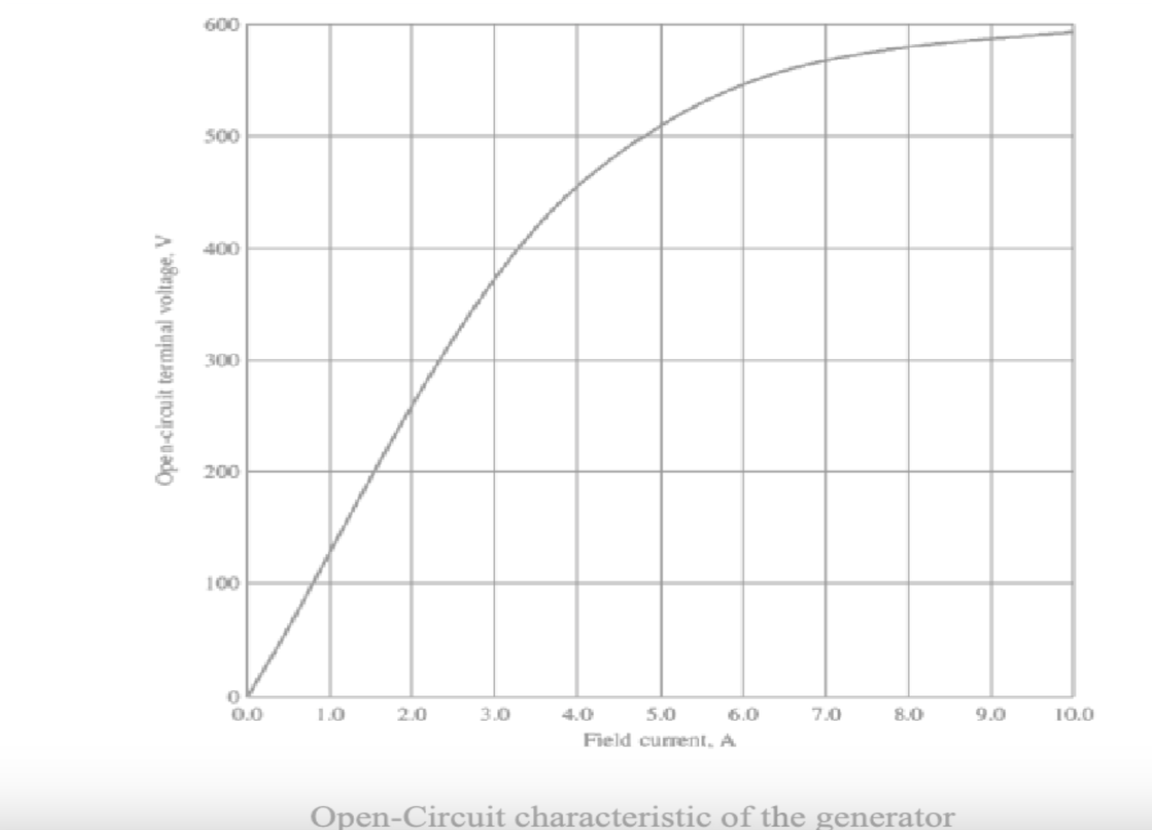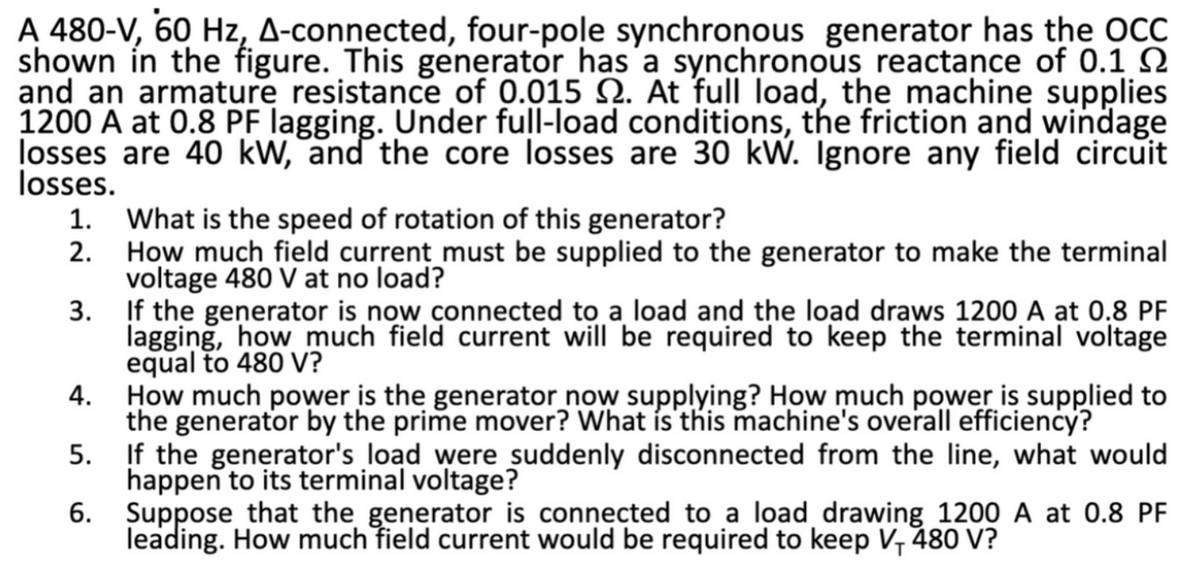shown in the figure. This generator has a synchronous reactance of and an armature resistance of 0.015 . At full load, the machine supplies 1200 A at 0.8 PF lagging. Under full-load conditions, the friction and windage losses are 40 kW, and the core losses are 30 kW. Ignore any field circuit losses. 1. 2. What is the speed of rotation of this generator? How much field current must be supplied to the generator to make the terminal voltage 480 V at no load? 3. If the generator is now connected to a load and the load draws 1200 A at 0.8 PF lagging, how much field current will be required to keep the terminal voltage equal to 480 V? 4. How much power is the generator now supplying? How much power is supplied to the generator by the prime mover? What is this machine's overall efficiency? If the generator's load were suddenly disconnected from the line, what would happen to its terminal voltage? 5. 6. pose that the generator is connected to a load drawing 1200 A at 0.8 PF leading. How much field current would be required to keep V, 480 V?
shown in the figure. This generator has a synchronous reactance of and an armature resistance of 0.015 . At full load, the machine supplies 1200 A at 0.8 PF lagging. Under full-load conditions, the friction and windage losses are 40 kW, and the core losses are 30 kW. Ignore any field circuit losses. 1. 2. What is the speed of rotation of this generator? How much field current must be supplied to the generator to make the terminal voltage 480 V at no load? 3. If the generator is now connected to a load and the load draws 1200 A at 0.8 PF lagging, how much field current will be required to keep the terminal voltage equal to 480 V? 4. How much power is the generator now supplying? How much power is supplied to the generator by the prime mover? What is this machine's overall efficiency? If the generator's load were suddenly disconnected from the line, what would happen to its terminal voltage? 5. 6. pose that the generator is connected to a load drawing 1200 A at 0.8 PF leading. How much field current would be required to keep V, 480 V?
Introductory Circuit Analysis (13th Edition)
13th Edition
ISBN:9780133923605
Author:Robert L. Boylestad
Publisher:Robert L. Boylestad
Chapter1: Introduction
Section: Chapter Questions
Problem 1P: Visit your local library (at school or home) and describe the extent to which it provides literature...
Related questions
Question
Please solve as Y-connected. thank u

Transcribed Image Text:Open-circuit terminal voltage, V
600
500
400
300
200
100
0
0.0
1.0
2.0
3.0
4.0
5.0
6.0
Field current, A
7.0
8.0
Open-Circuit characteristic of the generator
9.0
10.0

Transcribed Image Text:A 480-V, 60 Hz, A-connected, four-pole synchronous generator has the OCC
shown in the figure. This generator has a synchronous reactance of 0.1
and an armature resistance of 0.015 . At full load, the machine supplies
1200 A at 0.8 PF lagging. Under full-load conditions, the friction and windage
losses are 40 kW, and the core losses are 30 kW. Ignore any field circuit
losses.
1.
2.
What is the speed of rotation of this generator?
How much field current must be supplied to the generator to make the terminal
voltage 480 V at no load?
3.
If the generator is now connected to a load and the load draws 1200 A at 0.8 PF
lagging, how much field current will be required to keep the terminal voltage
equal to 480 V?
4.
How much power is the generator now supplying? How much power is supplied to
the generator by the prime mover? What is this machine's overall efficiency?
5.
If the generator's load were suddenly disconnected from the line, what would
happen to its terminal voltage?
6.
Suppose that the generator is connected to a load drawing 1200 A at 0.8 PF
leading. How much field current would be required to keep V, 480 V?
Expert Solution
This question has been solved!
Explore an expertly crafted, step-by-step solution for a thorough understanding of key concepts.
This is a popular solution!
Trending now
This is a popular solution!
Step by step
Solved in 6 steps with 18 images

Knowledge Booster
Learn more about
Need a deep-dive on the concept behind this application? Look no further. Learn more about this topic, electrical-engineering and related others by exploring similar questions and additional content below.Recommended textbooks for you

Introductory Circuit Analysis (13th Edition)
Electrical Engineering
ISBN:
9780133923605
Author:
Robert L. Boylestad
Publisher:
PEARSON

Delmar's Standard Textbook Of Electricity
Electrical Engineering
ISBN:
9781337900348
Author:
Stephen L. Herman
Publisher:
Cengage Learning

Programmable Logic Controllers
Electrical Engineering
ISBN:
9780073373843
Author:
Frank D. Petruzella
Publisher:
McGraw-Hill Education

Introductory Circuit Analysis (13th Edition)
Electrical Engineering
ISBN:
9780133923605
Author:
Robert L. Boylestad
Publisher:
PEARSON

Delmar's Standard Textbook Of Electricity
Electrical Engineering
ISBN:
9781337900348
Author:
Stephen L. Herman
Publisher:
Cengage Learning

Programmable Logic Controllers
Electrical Engineering
ISBN:
9780073373843
Author:
Frank D. Petruzella
Publisher:
McGraw-Hill Education

Fundamentals of Electric Circuits
Electrical Engineering
ISBN:
9780078028229
Author:
Charles K Alexander, Matthew Sadiku
Publisher:
McGraw-Hill Education

Electric Circuits. (11th Edition)
Electrical Engineering
ISBN:
9780134746968
Author:
James W. Nilsson, Susan Riedel
Publisher:
PEARSON

Engineering Electromagnetics
Electrical Engineering
ISBN:
9780078028151
Author:
Hayt, William H. (william Hart), Jr, BUCK, John A.
Publisher:
Mcgraw-hill Education,